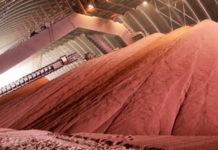
GLENCORE’S fourth quarter and full year production report sprung few surprises with year-on-year declines registered in copper, nickel and zinc.
A portion of Glencore’s lower output was due to technical issues but the Swiss group also sold assets, such as Cobar which contributed to a 5% year-on-year fall in copper to just over one million tons. The divestment from South American nickel assets also played a role in Glencore’s production of the base metal falling 9% to 97,600 tons in 2023.
More significantly, guidance for 2024 reflects potentially lower production for copper, nickel and zinc – a development that US investment bank Jeffries said would be a feature of supply in the key battery mineral markets in the medium-term.
“Production challenges have become common in the industry, and a lack of supply growth in most commodities in mining should lead to a squeeze higher in prices over the next 12+ months as long as the US economy does not materially weaken and take the rest of the world down with it,” said the bank’s analysts Christopher LaFemina and Patricia Hove.
They added that higher prices over time would offset the negative impact of declining volumes for Glencore. The same can be said for the world’s other diversified miners.
In January, BHP reported a slightly weaker-than-expected December quarter production with copper and metallurgical coal output underperforming Goldman Sachs expectations by 6% to 9%. Lower head grades at Escondida, under-performance at Spence in Chile were behind copper coming in 437,000 tons below consensus.
For miners that can grow, the outlook is especially strong. Goldman Sachs thinks the possibility of Glencore reaching 1.2 million tons a year in copper output by 2028 is a standout feature of the firm’s investment appeal.
Generally, however, miners are struggling to meet the future demands of the global energy transition, as indeed they have been warning for several years they will do.
“While the global risk backdrop will continue to dictate near-term copper price moves, the supply picture has materially changed over the past few months,” said Deutsche Bank analysts in a report published last month. Supply was structurally inelastic supporting a 2025 copper price of $10,000/t, the bank said.
How the global economy ‘lands’ is the single most important critical factor in deciding how metal demand behaves this year and perhaps the next. For instance, S&P Global Market Intelligence forecasts last year’s “narrowly averted US debt default” will continue into this year. Geopolitical risks may also feed into future demand.
China GDP has stabilised at 4.5% growth helped by policy easing, said Deutsche Bank which suggests the global economy ‘landing’ will be softer than first feared. Consensus for US GDP is around 1.25%, it said. But supply/demand fundamentals are firmly back in the frame.
“The industry has seen few new major discoveries, with established operations set to face production declines, stemming from operational challenges and naturally declining production profiles,” said Goldman Sachs analysts.
“We believe a much higher incentive copper price is required for miners to accept the risk of developing new supply in the current environment to address the growing supply deficit we anticipate later this decade,” it said.
The bank foresees a supply deficit of 500,000 tons by 2025 rising to a staggering five million tons five years later.









